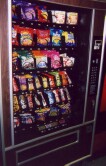
FRIDAY, Feb. 1 (HealthDay News) — The days when U.S. children can get themselves a sugary soda or a chocolate bar from a school vending machine may be numbered, if newly proposed government rules take effect.
The U.S. Department of Agriculture on Friday issued new proposals for the type of foods available at the nation’s school vending machines and snack bars. Out are high-salt, high-calorie fare, to be replaced by more nutritious items with less fat and sugar.
“Providing healthy options throughout school cafeterias, vending machines and snack bars will complement the gains made with the new, healthy standards for school breakfast and lunch so the healthy choice is the easy choice for our kids,” USDA Secretary Tom Vilsack said in an agency new release.
The new proposed rules focus on what are known as “competitive foods,” which include snacks not already found in school meals. The rules do not pertain to bagged lunches brought to school from home, or to special events such as birthday parties, holiday celebrations or bake sales — giving schools what the USDA calls “flexibility for important traditions.” After-school sports events are also exempted, the agency said.
However, when it comes to snacks offered elsewhere, the USDA recommends they all have either fruit, vegetables, dairy products, protein-rich foods, or whole-grain products as their main ingredients.
Foods to avoid include high-fat or high-sugar items — think potato chips, sugary sodas, sweets and candy bars. Foods containing unhealthy trans fats also aren’t allowed.
As for drinks, the USDA is pushing for water, unflavored low-fat milk, flavored or unflavored fat-free milk, and 100 percent fruit or vegetable juices. High schools may also make caffeinated beverages and calorie-free sodas available to students.
As the USDA noted, a report issued earlier this week by the federal Centers for Disease Control and Prevention found that 39 states have already implemented similar rules on school-based snacks. The new USDA rules “would establish a national baseline of these standards,” the agency said.
The proposals are now open for a 60-day period of public comment, and schools do not have to implement them until after a full school year passes following the rules’ final adoption by the USDA.
The nonprofit consumer advocate group Center for Science in the Public Interest said it “cheered” the new proposals.
“Under USDA’s proposed nutrition standards, parents will no longer have to worry that their kids are using their lunch money to buy junk food at school,” the group’s nutrition policy director, Margo Wootan, said in a news release.
“There’s been good progress on school foods over the last decade as a result of local school district and state policies and voluntary efforts by the soft-drink industry,” she added.
“But still, there are too many unhealthy foods and drinks in schools. Two-thirds of elementary school students and almost all high school students can buy foods and beverages outside of the meal programs in schools,” Wootan said. “Studies show that unhealthy snacks and drinks sold in schools undermine children’s diets and increase their weights.”
More information
There’s more on the new school snack proposals at the U.S. Department of Agriculture.

